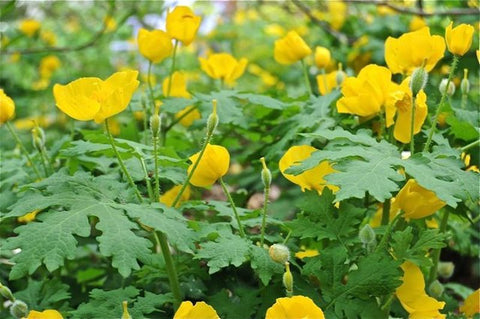The Christmas fern (Polystichum acrostichoides) is a species native to eastern North America, including the United States and Canada. It is named for its evergreen fronds, which remain green throughout winter and can provide a festive touch to holiday decorations.
The Christmas fern typically grows to a height of 1-2 feet and has a spread of 1-2 feet.
Its deep green fronds are arranged in a neat, symmetrical pattern. The fern can tolerate various soil types and light conditions, from full shade to partial sun.
One of the benefits of the Christmas fern is its hardiness and low maintenance requirements. It is a slow-growing plant that can thrive for many years with little care. The fern can also be easily propagated by dividing its rhizomes in the spring.
In addition to its decorative value, the Christmas fern has some medicinal uses. The plant contains a compound called pteron B.The Christmas fern is a beautiful and resilient plant that can add a touch of evergreen charm to any garden or holiday display.
The Turk's Cap Lily (Lilium superbum) is a lily species native to eastern North America. It is a tall, striking plant that grows up to 6 feet tall and produces a profusion of blooms in mid-summer.
Turk's Cap Lily gets its name from its unique shape. The flowers are pendant-shaped, like a turban or fez, with the petals curving inward toward the bloom's center. The flowers are typically bright orange-red and have dark spots at their base. They are highly fragrant and attract pollinators, including bees, butterflies, and hummingbirds.
The Turk's Cap Lily is an easy-to-grow and prefers well-drained locations and partial shade to full sun.
It tolerates a range of soil types of wide varieties as long as it is not too wet. The plant typically blooms mid-summer and requires minimal maintenance, though it can benefit from occasional fertilization and watering during dry spells.
In addition to its ornamental value, the Turk's Cap Lily has several medicinal uses. The plant contains anti-inflammatory and pain-relieving properties, and it has been used in traditional medicine to treat headaches, fever, and stomach cramps.
Trout lily (Erythronium americanum) is a spring-blooming wildflower native to eastern North America. It is also known by other names, such as fawn lily, dogtooth violet, and Adder's Tongue.
Trout lily plants have one or two broad, glossy leaves that resemble the markings on a trout's body, hence the name "trout lily." The leaves emerge in early spring and often have mottled or spotted patterns in shades of green and brown. The plant then produces a solitary, nodding flower that hangs from a leafless stem. The flower is yellow and resembles a miniature lily, with six petals and a cluster of stamens in the center.
TROUT LILIES ARE A POPULAR WILDFLOWER FOR NATURALIZING IN WOODLAND GARDENS OR NATURAL AREAS.
They prefer well-drained soil rich in the natural matter and partial to full shade. They grow best in relaxed, moist environments and thrive in woodlands, streams, riverbanks, and other damp, shady areas.
Trout lilies have several interesting ecological characteristics. They have evolved to rely on ants for seed dispersal, as the seeds have a fatty, nutrient-rich coating attractive to ants. Trout lilies are also considered a "spring ephemeral," meaning that they produce, flower, and set seed quickly before the tree canopy leaves out and shades them from the sun.
In addition to their ornamental value, trout lilies have medicinal properties. They contain compounds that have been shown to have anti-inflammatory and pain-relieving properties and have been used in general medicine to treat several ailments, including rheumatism and sore throats. However, it's important to note that wild plants should only be harvested for medicinal use with proper training and guidance from a qualified herbalist or botanist.
THE CELANDINE POPPY (STYLOPHORUM DIPHYLLUM) IS A HERBACEOUS PERENNIAL PLANT NATIVE TO EASTERN NORTH AMERICA.
It is also known as wood, yellow, and rock poppy.
The plant typically grows to 1-2 feet (30-60 cm) and has lobed, blue-green leaves arranged in a basal rosette. In early spring, the plant produces bright yellow flowers that resemble poppies, with four petals and a central cluster of stamens. The flowers are short-lived, but the plant can produce multiple blooms throughout the growing season.
Celandine poppies prefer to grow in partial to full shade and in moist, well-drained soil rich in organic matter. They often grow in woodlands, stream banks, and other shady, damp areas.
The plant has ornamental value in gardens and is used as a ground cover or border plant. It is relatively low-maintenance and can tolerate some drought once established.
The celandine poppy has also been used for medicinal purposes by Native American tribes. The plant contains alkaloids that have been shown to have pain-relieving and sedative effects, and it has been used in treating headaches, toothaches, and other types of pain. However, it's important to note that the plant should only be consumed with proper guidance from a qualified healthcare provider, as it can be toxic if ingested in large amounts.
Overall, the celandine poppy is a beautiful and adaptable plant that can add color and interest to shady areas of the garden.




